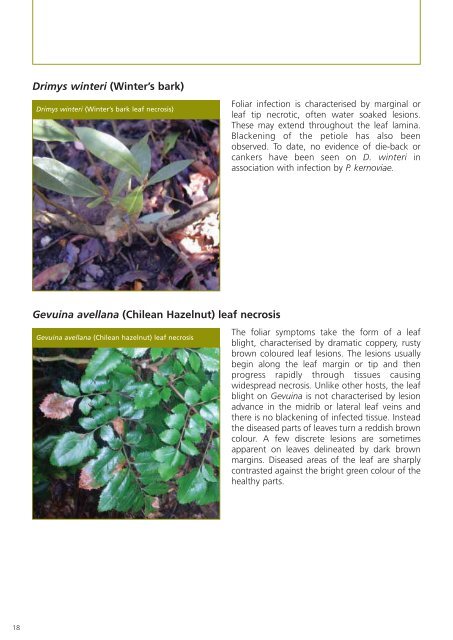Phytophthora ramorum - The Food and Environment Research ...
Phytophthora ramorum - The Food and Environment Research ...
Phytophthora ramorum - The Food and Environment Research ...
You also want an ePaper? Increase the reach of your titles
YUMPU automatically turns print PDFs into web optimized ePapers that Google loves.
Drimys winteri (Winter’s bark)<br />
Drimys winteri (Winter’s bark leaf necrosis)<br />
Foliar infection is characterised by marginal or<br />
leaf tip necrotic, often water soaked lesions.<br />
<strong>The</strong>se may extend throughout the leaf lamina.<br />
Blackening of the petiole has also been<br />
observed. To date, no evidence of die-back or<br />
cankers have been seen on D. winteri in<br />
association with infection by P. kernoviae.<br />
Gevuina avellana (Chilean Hazelnut) leaf necrosis<br />
Gevuina avellana (Chilean hazelnut) leaf necrosis<br />
<strong>The</strong> foliar symptoms take the form of a leaf<br />
blight, characterised by dramatic coppery, rusty<br />
brown coloured leaf lesions. <strong>The</strong> lesions usually<br />
begin along the leaf margin or tip <strong>and</strong> then<br />
progress rapidly through tissues causing<br />
widespread necrosis. Unlike other hosts, the leaf<br />
blight on Gevuina is not characterised by lesion<br />
advance in the midrib or lateral leaf veins <strong>and</strong><br />
there is no blackening of infected tissue. Instead<br />
the diseased parts of leaves turn a reddish brown<br />
colour. A few discrete lesions are sometimes<br />
apparent on leaves delineated by dark brown<br />
margins. Diseased areas of the leaf are sharply<br />
contrasted against the bright green colour of the<br />
healthy parts.<br />
18
















